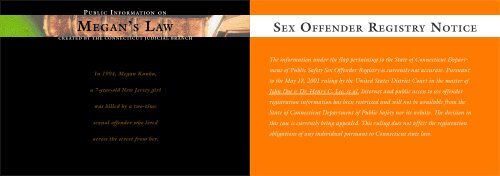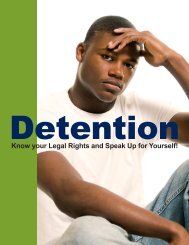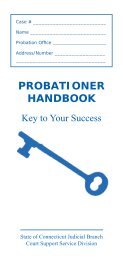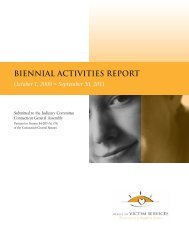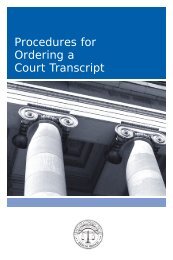Megan's Law paged for pdf - Connecticut Judicial Branch
Megan's Law paged for pdf - Connecticut Judicial Branch
Megan's Law paged for pdf - Connecticut Judicial Branch
You also want an ePaper? Increase the reach of your titles
YUMPU automatically turns print PDFs into web optimized ePapers that Google loves.
P UBLIC INFORMATION ON<br />
MEGAN’S LAW<br />
CREATED BY THE CONNECTICUT JUDICIAL BRANCH<br />
SEX OFFENDER REGISTRY NOTICE<br />
In 1994, Megan Kanka,<br />
a 7-year-old New Jersey girl<br />
was killed by a two-time<br />
sexual offender who lived<br />
across the street from her.<br />
The in<strong>for</strong>mation under the flap pertaining to the State of <strong>Connecticut</strong> Department<br />
of Public Safety Sex Offender Registry is currently not accurate. Pursuant<br />
to the May 18, 2001 ruling by the United States District Court in the matter of<br />
John Doe v. Dr. Henry C. Lee, et al. Internet and public access to sex offender<br />
registration in<strong>for</strong>mation has been restricted and will not be available from the<br />
State of <strong>Connecticut</strong> Department of Public Safety nor its website. The decision in<br />
this case is currently being appealed. This ruling does not affect the registration<br />
obligations of any individual pursuant to <strong>Connecticut</strong> state law.
MEGAN’S LAW<br />
COMMUNITY RESPONSE<br />
EDUCATION PROGRAM<br />
In 1995, as a result of Megan Kanka’s murder, <strong>Connecticut</strong>’s version of Megan’s <strong>Law</strong><br />
went into effect. Megan’s <strong>Law</strong> is, in essence, community notification of convicted sex<br />
offenders. Megan’s <strong>Law</strong> mandates that offenders register with police and notify officers<br />
when they change addresses.<br />
The Department of Public Safety was mandated by PA 98-111 to establish and maintain a centralized sex offender<br />
registry in the State of <strong>Connecticut</strong>. It was also required to make this in<strong>for</strong>mation available to the public. The Sex<br />
Offender Registry Unit came into existence in October of 1998 and registry in<strong>for</strong>mation was published on a web<br />
site as of December 30, 1998.<br />
The Sex Offender Registry Unit monitors over 2,100 offenders within the state. Members of the Unit complete<br />
and verify sex offender registrations and respond to questions generated by police agencies and the public. The<br />
addresses of all sex offenders are updated on a ninety day or annual basis depending on conviction and conditions<br />
of release. <strong>Law</strong> en<strong>for</strong>cement officials throughout the state are notified when a registered sex offender resides in<br />
their town.<br />
The State of <strong>Connecticut</strong> <strong>Judicial</strong> <strong>Branch</strong>, in collaboration with the Department of Public Safety, the Board of<br />
Parole, the <strong>Connecticut</strong> Sexual Assault Crisis Services, Inc., and Connections, Inc., has developed a program<br />
designed to explain to parents and children how to better protect themselves from sexual assault and abuse.<br />
A panel of statewide experts in law en<strong>for</strong>cement, sex offender treatment and sexual assault victims’ services<br />
travel throughout the state to provide in<strong>for</strong>mation to members of the public about the myths and facts about<br />
sex offenders, ways to protect themselves and their children from abuse, and what in<strong>for</strong>mation they are entitled<br />
to receive under <strong>Connecticut</strong>’s version of Megan’s law.<br />
If you are interested in learning more about this program, please contact the External Affairs Division<br />
of the <strong>Connecticut</strong> <strong>Judicial</strong> <strong>Branch</strong> at (860) 757-2270.<br />
To access the Department of Public Safety’s sex offender registry, log onto www.state.ct.us/dps.
WHO ARE SEX OFFENDERS?<br />
When most people hear “sex offender,” they think of sexual assault - child molesters,<br />
rapists, strangers who have accosted victims. In fact, sexual offenders can be defined<br />
two ways: legally and clinically. No matter what the definition, it must be kept in<br />
mind that the vast majority of sexual offense victims are assaulted by a family member<br />
or an acquaintance, not by a stranger.<br />
WHAT ARE THE LEGAL DEFINITIONS OF “SEX OFFENDER”?<br />
A “sex offender” is a person who has been convicted of one of this state’s laws relating to sexual behavior. Charges<br />
may range from felony sexual assault involving <strong>for</strong>cible intercourse to public indecency.<br />
While legal definitions address the cases of serious sexual assault feared by most citizens, they also include sexual<br />
activities that are not a threat to most citizens -- activities that are illegal, but are consensual. For example, an<br />
18-year-old adult engaging in sexual contact with a 15-year-old minor can be prosecuted, even when that activity<br />
is consensual. By law, the 15-year-old is unable to “consent” to sexual activity.<br />
WHAT ARE THE CLINICAL DEFINITIONS OF “SEX OFFENDER”?<br />
Clinicians are concerned primarily with the cases of non-consensual sexual contact that are feared by most of us.<br />
While sexual offenses can be broken down into many categories, there are two overarching types of sexual<br />
offenses -- those involving child sexual abuse, and rape -- and within those categories there are two primary types<br />
of offender motivation and behavior.<br />
CHILD SEXUAL ABUSE: A child sexual abuser is an adult who has sexual activity of any kind with a child<br />
or youth 17 or younger. Child molestation occurs most frequently when the child is between the ages of 5<br />
and 11. However, abuse can occur from birth until adulthood (age 18). There are two primary types of<br />
child sexual abusers:<br />
REGRESSIVE MOLESTERS (the majority of child molesters) are interested primarily in adults, but, often<br />
because of personal inadequacies, find it more com<strong>for</strong>table and pleasing to be sexually involved with a<br />
child. This is the most common type of child sexual abuser. The abuser is usually a family member or one<br />
who knows the child, and the abuse often begins with sexual fondling.<br />
FIXATED MOLESTERS (about 35% of child molesters) are those who are typically called pedophiles, and<br />
who are feared by most parents. Most people who molest children are not pedophiles. To be a pedophile,<br />
one must have an ongoing pervasive interest in sexual activity with children.<br />
RAPE: There are two predominant types of rapists:<br />
ANGER RAPISTS commit a rape as a way of acting out extreme anger. They tend to use physical violence.<br />
The victim is often bruised or hurt and has identifiable bruises.<br />
POWER OR CONTROL RAPISTS look <strong>for</strong> control or power over another person. They use coercion or<br />
the threat of violence instead of actual physical violence.
WHAT IS CHILD SEXUAL ABUSE?<br />
A guide <strong>for</strong> parents to teach their children personal safety rules to reduce their risk<br />
of sexual abuse.<br />
SEXUAL ABUSE INCLUDES:<br />
• Fondling or touching the child’s private parts, or <strong>for</strong>cing the child to touch another’s private parts.<br />
• Exposing children to adult sexual activity or pornographic materials.<br />
• Having children per<strong>for</strong>m in pornographic movies, or pose <strong>for</strong> pornographic materials.<br />
• Sexual intercourse.<br />
SIGNS OF POSSIBLE ABUSE INCLUDE:<br />
(These signs are possible indicators and do not necessarily mean sexual abuse has occurred.)<br />
• Excessive clinging or crying.<br />
• Sleep disturbances; nightmares.<br />
• Fear of particular adults or places.<br />
• Bed-wetting.<br />
• Problems with school (refusal to attend, or a drop in grades).<br />
• Depression; withdrawal from family and friends.<br />
• Alcohol or drug use.<br />
• Change in eating habits.<br />
• Frequent touching of private parts.<br />
• Unexplained bleeding, pain, irritation of mouth or private parts.<br />
• Any unexplained change in behavior, or development of new behaviors.<br />
TEACH YOUR CHILD THESE PERSONAL SAFETY RULES<br />
• The difference between safe and unsafe touches; what is appropriate physical affection.<br />
• The proper names <strong>for</strong> all their private parts; many children are not able to tell about the abuse because they<br />
don’t know the words to use.<br />
• Safety rules apply to all adults; not just strangers.<br />
• Their bodies belong to them and it is not okay <strong>for</strong> another person to touch their private parts.<br />
• It is okay to say no if someone tries to touch their body or do things that make them feel uncom<strong>for</strong>table,<br />
no matter who the person is.<br />
• They should not keep secrets about touching, no matter what the person says. If someone touches them,<br />
tell and keep telling until someone listens.<br />
STATISTICS<br />
• 1 in 4 girls and 1 in 6 boys will be sexually assaulted be<strong>for</strong>e age 18. 1<br />
• 90% of child sexual abuse is committed by relatives, close family friends or an adult that the child knows<br />
and trusts. 2<br />
• The median age that girls and boys are sexually abused is 9 years old. 3<br />
• In <strong>Connecticut</strong>, 32% of victims seen at sexual assault crisis services in 1999-2000 were under the age of 18. 4<br />
1 Diane Russell, The Secret Trauma, N.Y.:Basil Books, 1986. 2 Dean Kilpatrick et al, Rape in America: A Report to the Nation, Arlington, VA, 1992 and<br />
Finkelhor, David, 1994, “Current In<strong>for</strong>mation on the Scope and Nature of Child Sexual Abuse”, The Future of Children 14(2):31, 46-48. 3 Finkelhor,<br />
David, 1990, “Sexual Abuse in a National Survey of Adult Men and Women: Prevalence, Characteristics and Risk Factors.” Child Abuse and Neglect 14:<br />
19-28. 4 CONNSACS Annual Report 2000.<br />
Note: You may want to include your conversation about personal safety rules when teaching your child about<br />
fire safety, bike safety, or traffic safety. You should role play the above rules (lessons) several times.<br />
Do not expect your child to memorize them.
DATE/ACQUAINTANCE RAPE<br />
One out of four women reported being the victim of rape or attempted rape<br />
during their college years.<br />
Whether a high school teenager, a college student or an adult, there are those who are victims of date or<br />
acquaintance rape. Below are some definitions that apply in these situations.<br />
RAPE: a crime of power and control in which one person <strong>for</strong>ces, coerces, or manipulates another person into<br />
sexual intercourse.<br />
STATUTORY RAPE: sex between a person who is 13-15 years old and a person who is two or more years older.<br />
DATE/ACQUAINTANCE RAPE: date rape means that the rape was committed on a date. Acquaintance rape<br />
means that someone the victim knows committed the rape.<br />
SEXUAL ASSAULT: occurs when a person <strong>for</strong>ces another person to engage in certain sexual activities by the use of<br />
<strong>for</strong>ce or without the other person’s consent. The law defines certain people of being incapable of giving consent,<br />
such as youth of a certain age or people of a particular mental capacity.<br />
INCEST: when the offender is a family member.<br />
PERSONAL SAFETY TIPS<br />
• Trust your feelings: If you feel uncom<strong>for</strong>table with a situation, follow your instincts and get out of the situation.<br />
• Know your limits: Decide what you are willing and unwilling to do sexually. Stick to your limits and spend time<br />
with people who respect them.<br />
• Be assertive: Say NO if someone is trying to intimidate or pressure you into something you don’t want to do.<br />
Be firm and direct.<br />
• Pay attention and be aware of behavior that is disrespectful to you: Someone who gets hostile when you say no,<br />
ignores your wishes or opinions, or tries to make you feel guilty <strong>for</strong> saying no, does not respect your wishes.<br />
AT PARTIES, ON DATES<br />
• Don’t leave your drink unattended. Never take an open container drink or drink from a punch bowl.<br />
• Pour your own drink or watch the person pour it. People sometimes put drugs in drinks in order to rape a person.<br />
• Think carefully about leaving a party with someone you just met.<br />
• Friends should “watch out” <strong>for</strong> each other.<br />
• Set your own limits and decide how far you want the date to progress be<strong>for</strong>e going out.<br />
• Let someone know where you are going.<br />
• Find out as much as possible about the person be<strong>for</strong>e going out on a date.<br />
• Carry money <strong>for</strong> a phone call, your own dinner or a cab ride home.<br />
• Remember that the same precautions should be followed whether you’re in high school, middle school or college.<br />
• It is important to remember that NO does not mean YES and a person can say NO any time.<br />
• When going out at night, always walk with a group of friends.<br />
• Be aware of your surroundings so that if you need to leave a situation, you know where to go.<br />
HOW TO HELP A FRIEND, CHILD OR FAMILY MEMBER WHO HAS BEEN SEXUALLY ASSAULTED<br />
• Believe that person.<br />
• Tell them that they are not to blame <strong>for</strong> the assault.<br />
• Don’t gossip about the assault.<br />
• Urge them to get medical assistance.<br />
• Remember, your supportive response will help the victim to deal with the trauma of the abuse.<br />
• Ask be<strong>for</strong>e touching the victim.<br />
• Don’t pressure them to give any details; allow the victim to talk at their own pace.<br />
• Call the sexual assault hotline if you have questions or need support <strong>for</strong> yourself.<br />
• Deal with your anger another time.
PROTECTING YOUR CHILD ONLINE<br />
“Surfing the net” means different things to different people. For some, it means a<br />
quick look at the local news, <strong>for</strong> others it means a day of learning about their<br />
newest hobby, and <strong>for</strong> many it simply means a fun and educational way to spend<br />
their spare time.<br />
The term online refers to any communication that occurs on the internet (email, websites, etc). Un<strong>for</strong>tunately, the<br />
internet can also be used in ways that hurt children. For example, the rapid growth of the internet has allowed <strong>for</strong><br />
easy access to, and exchange of, pornographic material. In addition, some sex offenders may use the internet to<br />
identify and make contact with potential child victims.<br />
WHAT ARE THE LAWS RELATED TO SEXUAL EXPLOITATION ON THE INTERNET?<br />
In general there are two types of laws which can be used to address online sexual exploitation. Those which are<br />
designed to <strong>for</strong>bid visual depiction of children engaging in sexual acts and those which are designed to protect<br />
children from becoming victims of sex offenders by those who attempt to contact them via the internet.<br />
Often these crimes violate federal and state laws because the internet can be used by a person from one state to<br />
lure a child from another state into sexual activities and/or to send child pornography between states.<br />
RESOURCES FOR PARENTS AND GUARDIANS<br />
Family Guidebook -- A parent’s guidebook to the internet - www.familyguidebook.com<br />
PedoWatch -- pedowatch.org/parenting.html<br />
Cyberangels -- cyberangels.org/about/index.html<br />
National Center <strong>for</strong> Missing and Exploited Children -- www.missingkids.com<br />
GUIDELINES FOR PARENTS AND GUARDIANS (Adapted from Child Safety on the In<strong>for</strong>mation Highway.<br />
Reprinted with permission from the National Center <strong>for</strong> Missing and Exploited Children, 1994.)<br />
• Get to know your computer. Spend time with your child online. Ask your child to show you their favorite website(s).<br />
• Talk to your child about sexual exploitation and potential dangers when using the internet.<br />
• Tell your child that if they feel uncom<strong>for</strong>table with something that has happened online, they should tell you<br />
immediately.<br />
• Tell your child that they should never arrange a face-to-face meeting with someone they “met” online.<br />
• Do not allow your child to respond to messages or bulletin board items that are suggestive, obscene or<br />
threatening.<br />
• Remind your child to never share personal in<strong>for</strong>mation (name, address, etc.) or pictures of themselves on the<br />
internet.<br />
• Keep the computer in the family room where you can monitor your child’s activities.<br />
• Share an email account with your child so you are aware of the types of email they receive.<br />
• Do not allow your child to go into private chat rooms.<br />
• Monitor your credit card bills.<br />
• Consider an online service that has special child accounts with restricted access to chat rooms and the internet.<br />
• It is important to discuss the above personal safety rules with your child several times.<br />
SIGNS THAT YOUR CHILD MAY BE AT RISK ON THE INTERNET<br />
• Spends a lot of time online, especially at night.<br />
• You find pornography on your child’s computer.<br />
• Your child receives phone calls from people you don’t know, or is making long distance calls to numbers you<br />
don’t recognize.<br />
• Your child receives mail or gifts from unknown individuals.<br />
• Your child quickly turns off the computer when you enter the room.
MYTHS & FACTS<br />
Dispelling myths about sexual offenses can help in prevention, protection and recovery.<br />
Myth: Child molesters typically use physical <strong>for</strong>ce and/or threats to gain compliance from their victims.<br />
FACT: Only 10-15% of child molesters use physical <strong>for</strong>ce or threats to gain compliance from their victims. In fact,<br />
many child molesters will entice their victims through grooming, which is a process by which the offender <strong>for</strong>ms a<br />
relationship with his victim. Through grooming, the offender encourages the victim to trust him and to keep his<br />
actions a secret.<br />
Myth: Most child molesters are “dirty old men.”<br />
FACT: While it’s true that the vast majority of sexual offenders are males, research suggests that approximately<br />
20% of sex offenses against children are committed by females. Adults are identified abusers in two-thirds of the<br />
assaults, and the remaining one-third of abusers are under the age of 18 years. Men who offend against children<br />
are typically in their late 20s or early 30s, with the average age being 26-27. Aside from their offending behavior,<br />
most lead what would appear to be an average lifestyle. Child molesters can come from any socio-economic<br />
background, religious affiliation, or ethnic group.<br />
Myth: Children generally recover from the effects of sexual abuse on their own. It is best to keep the abuse a<br />
secret, so that they don’t have to endure talking to anyone else about it.<br />
FACT: The level of trauma that is incurred as a result of sexual abuse is based on many different factors, including,<br />
but not limited to, the following:<br />
• Whether or not the victim is believed by significant others who can be of assistance to the victim (parents, police,<br />
teachers, school counselors, etc).<br />
• Whether or not the victim is supported by significant others.<br />
• Whether or not the victim feels that he/she is being protected from further abuse.<br />
• Whether or not the victim is provided with counseling in a safe, nurturing environment.<br />
It is important <strong>for</strong> the level of trauma to be assessed by a professional, and <strong>for</strong> a course of treatment to be<br />
established based on this and other pertinent factors.<br />
Myth: Men who often rape do so because they have been unsuccessful in <strong>for</strong>ming intimate relationships, and they<br />
cannot find a consenting adult sexual partner.<br />
FACT: Studies suggest that most rape offenders are married or in consenting adult relationships when they commit<br />
their offenses.<br />
Myth: Young children often lie by making up stories of sexual abuse.<br />
FACT: Cases in which children make up stories about sexual abuse are very rare. In the case of very young children,<br />
most do not have the knowledge or vocabulary to make up such stories. On the contrary, however, research<br />
has shown that most sex offenders lie to themselves and others about their offenses, (at least initially) and may try<br />
to blame their victims.<br />
Myth: If a child doesn’t tell anyone about the sexual assault, then he/she must not have cared.<br />
FACT: Children often don’t tell <strong>for</strong> reasons such as fear, shame, embarrassment, wanting to protect their parents,<br />
or <strong>for</strong> many other reasons. Some common fears include:<br />
• The fear of being held responsible (blamed) <strong>for</strong> the abuse.<br />
• The fear of being punished.<br />
• The fear of the offender doing harm to themselves or their families if they tell of the abuse.<br />
• The fear of losing an important person in their life (the offender) to the authorities, who may remove the<br />
offender from the home.<br />
This fear is often the result of the offender telling the victim that if he/she tells, the victim will never get to see the<br />
important person (the offender) again. Remember, victims often have some kind of relationship with the offender.<br />
They are often emotionally attached to the offender in some way, and while they do not like the abuse, they tolerate<br />
it in order to maintain the connection/relationship with the offender. Many child molesters prey on these and<br />
other fears in children as a way of keeping the child silent.
FOR HELP/LEARN MORE<br />
There is little evidence that children make false allegations of abuse. What is more<br />
common is a child denying that abuse happened when it did.<br />
CALL TOLL FREE SEXUAL ASSAULT HOTLINE<br />
1-888-999-5545<br />
[en Español 1-888-568-8332]<br />
WHAT PARENTS SHOULD KNOW<br />
• Every child is vulnerable to sexual abuse regardless of cultural background or income level.<br />
• Children need to feel loved, valued and protected.<br />
• Children are best protected by giving them the knowledge and skills necessary <strong>for</strong> their safety and well-being.<br />
• Often there are no physical signs of sexual abuse.<br />
• Many cases of child sexual abuse go unreported because the child is afraid or ashamed to tell anyone what<br />
has happened.<br />
• The offender may have threatened to hurt a family member, or the child feels that he/she is to blame <strong>for</strong><br />
the abuse.<br />
• It is important to show interest in your child’s activities. Let him/her know that you are available to talk and<br />
listen. Allow your child to share thoughts and feelings with you.<br />
• The child is never to blame <strong>for</strong> the abuse; children cannot prevent abuse, only the offender can.<br />
• Studies suggest that personal safety rules can be taught and understood by children ages 3 and up.<br />
IF YOU HAVE BEEN SEXUALLY ASSAULTED<br />
• Talk to a friend that you feel com<strong>for</strong>table confiding in and call the sexual assault hotline.<br />
• The hotline is available anytime day or night you want to talk. It’s free, confidential and you don’t have<br />
to give your name.<br />
• Remember that you can’t control another’s persons behavior. It’s not your fault.<br />
• Consider getting medical assistance.<br />
• You are not alone.<br />
WAYS TO SUPPORT YOUR CHILD IF HE/SHE HAS BEEN ABUSED<br />
• Believe your child.<br />
• Reassure your child that his/her safety is important.<br />
• Assure your child that he/she is not to blame <strong>for</strong> the abuse.<br />
• Remember that how you respond to your child is critical to his/her ability to deal with the trauma of the abuse.<br />
• Don’t pressure your child to talk (or stop talking) about the abuse. Allow your child to talk at his/her own pace.<br />
• Get your child medical help.<br />
Explain to your child what you need to do to help him/her. Get support <strong>for</strong> yourself; this is a difficult issue <strong>for</strong><br />
any parent to handle. Call your local sexual assault crisis center <strong>for</strong> assistance <strong>for</strong> your child and yourself.
IMPORTANT NUMBERS<br />
Center <strong>for</strong> Women and Families E. Fairfield County, Inc. Rape Crisis Services (203) 333-2233<br />
Women’s Center of Greater Danbury Sexual Assault Crisis Services (203) 731-5204<br />
YWCA of the Hart<strong>for</strong>d Region Sexual Assault Crisis Services (860) 522-6666<br />
YWCA of the Hart<strong>for</strong>d Region Sexual Assault Crisis Services SE <strong>Connecticut</strong> (888) 999-5545<br />
Women and Families Center Middletown (860) 635-4424<br />
Meriden (203) 235-4444<br />
SE <strong>Connecticut</strong> (860) 437-7766<br />
Rape Crisis Center of Mil<strong>for</strong>d (203) 878-1212<br />
New Britain YWCA Sexual Assault Crisis Services (860) 223-1787<br />
Coordinating Council <strong>for</strong> Children <strong>for</strong> Children in Crisis, Inc.<br />
Sexual Assault Crisis Services of Greater New Haven (203) 624-2273<br />
Sexual Assault Crisis Center, Inc. (Stam<strong>for</strong>d) (203) 329-2929<br />
Susan B. Anthony Project, Inc. (Torrington) (860) 482-7133<br />
Safe Haven of Greater Waterbury (203) 753-3613<br />
Women’s Center <strong>for</strong> Northeastern <strong>Connecticut</strong>, Inc.<br />
Sexual Assault Crisis Service (Willimantic) (860) 456-2789<br />
or call toll free 1-888-999-5545 [en Español 1-888-568-8332]. You will be connected to the nearest sexual<br />
assault crisis service. Each center can provide in<strong>for</strong>mation and referral, advocacy <strong>for</strong> children and non-abusing<br />
parent with police and court, counseling, support groups, and more.<br />
This project has been funded with a grant from the US Department of Justice, Office of Justice Programs, Bureau of Justice Statistics.


